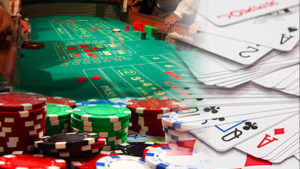Home » Nerd Nook » Betting Systems » Kelly Criterion
 Author:
Taylor Smith
| Last Updated:
June 2025
Author:
Taylor Smith
| Last Updated:
June 2025
If you’ve ever blown through your bankroll after “just one more bet,” the Kelly Criterion might be your new best friend. It’s a mathematical strategy that tells you exactly how much to bet when the odds are in your favor — not too much, not too little, just the sweet spot. Think of it as a bankroll map for online gambling.
Whether you’re playing blackjack, placing sports bets, or dabbling in online poker, the Kelly Criterion can help you maximize profits while protecting yourself from going bust. In this guide, we’ll break down how to apply this theory to gambling.
The Kelly Criterion is a formula used to determine the optimal size of a bet based on your edge and the odds offered. It was originally developed by data scientist John Kelly in 1956 to optimize signal-to-noise ratios, but gamblers quickly recognized its value for bankroll management and risk control.
The formula is:
Where:
It’s designed to strike a balance. If you bet too little, you miss out on profits. If you bet too much, you risk going broke when the variance turns against you.
How to Estimate Your EdgeBefore you can use the Kelly Criterion, you need one crucial number: your edge. This is the percentage advantage you believe you have over the house, the sportsbook, or your opponents. But estimating this isn’t just about guessing or wishful thinking. It takes data, discipline, and a lot of self-awareness.
If you’re betting on sports, your edge is the difference between your implied probability and the actual win probability. This can be determined by a sharp model, historical data, or closing line value (CLV).
For example, if a sportsbook gives you +120 odds (implied probability of ~45.5%) on a team you believe wins 50% of the time, your edge is 4.5%. In games like blackjack or video poker, your edge can be calculated based on perfect strategy tables or card counting techniques. In poker, it’s a bit murkier. Your edge comes from outplaying your opponents consistently, which means tracking long-term win rates (like BB/100 hands) and adjusting for variance.
Here’s the catch:
Most players overestimate their edge, sometimes wildly. So if you’re not sure, err on the side of caution. Cut your estimated edge in half or use a conservative range. Even a small, real edge can compound beautifully with Kelly. But an imaginary edge? That’s a fast track to going broke with “optimal” bet sizing. The Kelly formula can’t save you if the numbers you feed it are fiction.
Let’s say you’re betting on a tennis match. The sportsbook is offering +150 odds (which is 2.5 in decimal format). You estimate the underdog has a 45% chance of winning.
Here’s how you’d use the Kelly formula:
Now plug it into the formula:
The result: You should wager 8.3% of your bankroll on this bet.
If your bankroll is $1,000, that means betting $83. Not $200, not $500 — just $83. It keeps you aggressive when you have an edge, but not reckless.
Why the Kelly Criterion Works for Online GamblingOnline gambling is particularly suited to the Kelly formula because it allows for frequent betting and data-driven decision-making. Here’s why it fits:
One of the biggest advantages of applying the Kelly Criterion to online gambling is that you’re often working with well-defined probabilities. In sports betting, for example, you can calculate implied probabilities from the odds. The house edge is known and consistent in games like blackjack or video poker. Even when chasing bonus offers, you usually have enough information to estimate your expected value with at least some confidence. This is important because the Kelly formula requires a reliable edge estimate to function properly.
Without trustworthy numbers, the formula can lead you astray, but online gambling provides the kind of data-rich environment that makes Kelly feasible. Unlike casual home games or unclear casino rules, the online space is transparent and standardized. This allows players to make data-driven decisions, which helps to reinforce good habits like value betting and expected value calculation..
The Kelly Criterion is built for the long haul. The idea is that you’re compounding small advantages over several bets, which aligns perfectly with the structure of online gambling. You can place hundreds of bets across different sports, casino promos, poker hands, or blackjack sessions, all from your couch. This repetition allows your edge to express itself and smooth out variance over time.
Infrequent bets or one-off opportunities don’t let the math behind Kelly shine. But when you’re betting frequently with a slight edge, Kelly helps optimize your growth while managing risk. Online gambling environments are ideal for this because they support high-volume, low-friction play, which is exactly what you need to get the most out of a Kelly-based strategy.
Many gamblers go broke not because they lack skill, but because they bet too much when they finally do have an edge. The Kelly Criterion solves this by dynamically sizing bets to avoid overexposure. It’s not just about maximizing return, it’s also about minimizing the risk of ruin. This balance is particularly important in online gambling, where the ease of access can tempt players into going all-in too often.
By recommending smaller bets when your edge is small (or skipping bets when you have none), Kelly keeps your bankroll alive long enough to let your skill and edge pay off. It’s a tool that builds discipline — something that online gamblers, exposed to constant betting opportunities, can seriously benefit from. With Kelly, your bankroll becomes a long-term weapon, not a short-term gamble.
The Kelly Criterion isn’t the end-all-be-all of bankroll management. It should be used in tandem with other safe gambling practices, as well. New gamblers often fall into these common mistakes while using the Kelly Criterion:

This is arguably the most dangerous mistake you can make with the Kelly Criterion. If you think you have a 60% edge when your true edge is only 52%, you’ll be betting too much, too often, which can rapidly drain your bankroll. Overconfidence leads to oversized bets, which multiply variance and risk unnecessarily. Kelly assumes your edge is accurate, so inflating that number sabotages the entire formula.
A good rule of thumb is to be conservative. If you’re unsure about your edge, cut it in half. Many professional gamblers apply a “fudge factor” to their estimates for safety. While this might reduce short-term returns, it also shields your bankroll from volatility and bad luck. Remember, Kelly rewards accuracy, not optimism.

While the full Kelly formula is mathematically optimal for maximizing growth, it’s also extremely aggressive. It assumes you’re okay with the wild swings that come with high volatility. In practice, most sharp bettors use a fraction of Kelly, usually half, to tame the ride. For instance, if Kelly recommends an 8% bet, a more cautious gambler might wager 4% instead.
This concept, known as “fractional Kelly,” smooths out the volatility curve without completely sacrificing long-term growth. It’s a smart compromise that acknowledges the psychological toll of large downswings. Unless you have nerves of steel and a perfectly calculated edge, dialing back your Kelly stake is often the wisest move.

The Kelly Criterion is not a magic bullet — it only works if you have a genuine edge. If you’re playing a game with a negative expected value, like most online slots or roulette, Kelly will either tell you not to bet or falsely guide you if you’re overestimating your chances. That’s why using Kelly on random chance-based games is not just ineffective — it’s outright dangerous.
Where Kelly shines is in games where skill or information gives you a real edge: poker, blackjack (with perfect strategy or card counting), sports betting (with sharp models), or casino promos that offer positive EV. If you’re applying Kelly without an edge, you’re just using fancy math to lose money faster. Save it for when the numbers are truly in your favor.
If you’re betting with any sort of edge—line shopping, card counting, poker grinding, or exploiting bonuses — yes, you should be using the Kelly Criterion in some form. It’s not a system to “beat the house.” It’s a strategy to help you bet smarter when you already have a reason to wager.
For casual gamblers just looking to have fun, it may feel overly rigid. But for anyone serious about gambling as a long-term endeavor, Kelly is one of the best betting systems out there.
The Kelly Criterion isn’t a magic bullet, but a powerful tool for smarter bankroll management. In online gambling, it provides a mathematically sound strategy to protect your bankroll and maximize long-term growth.
If you’ve ever wondered how much to bet when you know you’ve got an edge, this is the answer.
Want to test it out? Next time you place a bet, run the numbers through Kelly first. Your bankroll might thank you later.

Taylor Smith is a skilled iGaming writer and content editor. He started writing for GamblingNerd.com in 2017 and became a content specialist in 2022. He majored in radio and film in college. After a transition to writing about online gambling, he now has over ten years of experience in the field. Yes, he’s heard your Taylor Swift jokes.

